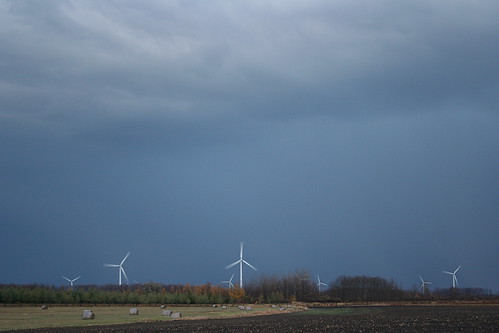How does a windmill power generator keeps a constant voltage, eg: 110 volts, when the wind is not constant?

Image by BevKnits
I’ve never gotten a shot of lightning and there was some pretty intense lightning tonight. I just missed getting a shot here but I thought the windmills looked neat in the shot. I’m holding the camera with my hands, not on a tripod. Pretty stead hands eh?? lol.
Question by maverick: How does a windmill power generator keeps a constant voltage, eg: 110 volts, when the wind is not constant?
Feel free to answer in the comment section below

It keeps voltage constant because it series combination circuit. and when the voltage [potential difference] drops then it come to a constant value, and that is a fact, but the current changes from higher value to lower value.
Malik Umer Farooq
December 21, 2011 at 10:51 am
The simplest method is to introduce a speed governor. Another is a flywheel for when the speed of the windmill drops. Another is a speed governed clutch.
Mickypoo
December 21, 2011 at 11:02 am
Usually the same way your car’s alternator does it: the current to the field coils in the alternator is adjusted.
The output voltage depends on the rotation rate and on the field strength. Reducing the field reduces the voltage.
redbeardthegiant
December 21, 2011 at 11:05 am
variable pitch blades varied by governor
Alan
December 21, 2011 at 11:46 am
if it is connected to the grid (infinite bus), the output voltage and frequency remain constant, however, the power generated varies.
Who Cares?
December 21, 2011 at 12:07 pm
Older style wind generators rotate at a constant speed, to match power line frequency, which allowed the use of less costly induction generators. Commercial size generators have a rotor carrying a field winding so that a rotating magnetic field is produced inside a set of windings called the stator. While the rotating field winding consumes a fraction of a percent of the generator output, adjustment of the field current allows good control over the generator output voltage.
Newer wind turbines often turn at whatever speed generates electricity most efficiently. This can be solved using multiple technologies such as doubly fed induction generators or full-effect converters where the variable frequency current produced is converted to DC and then back to AC, matching the line frequency and voltage.
Doubly-fed electric generators have windings on both stationary and rotating parts, where both windings transfer significant power between shaft and electrical system. The principle of the DFIG is that rotor windings are connected to the grid via slip rings and back-to-back voltage source converter that controls both the rotor and the grid currents. Thus rotor frequency can freely differ from the grid frequency (50 or 60 Hz). By using the converter to control the rotor currents, it is possible to adjust the active and reactive power fed to the grid from the stator independently of the generator’s turning speed. The control principle used is either the two-axis current vector control or direct torque control (DTC).
SammiChengHK
December 21, 2011 at 12:14 pm